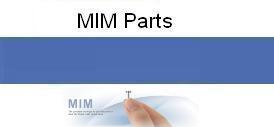6th Jan, 2012
The world metal injection molding and ceramic injection molding market
is forecast to reach $3.7 billion by the year 2017, according to a new
comprehensive report by US market analysts Global Industry Analysts, Inc
(GIA).
In the recession period, an increased productivity and capacity
requirements in key end-use markets will push demand for metal injection
molding (MIM) and ceramic injection molding (CIM) parts as manufacturers
begin channelling investments for global competitiveness.
As a metal-forming process, Metal Injection Molding brings together the
design flexibility of plastic moulding and material flexibility of
powder metallurgy. Even intricate shaped parts require just minor
finishing treatments. The Metal Injection Molding process offers
economical cost solutions for several applications compared to
investment casting or machining, and improved mechanical properties in
comparison to other net-shaping techniques such as zinc or aluminium die
casting. It also offers high-volume production, part to part
consistency, high performance, excellent surface finish, weight savings,
close porosity, surface finish, and high final density, among others.
The business prospects of the metal injection molding and ceramic injection molding
industry is closely tied to the consumer, telecommunications,
electronics, dental, medical, automotive and aerospace industries, among
others. While the industry flourished in US and Europe early in the
decade, it was affected by economic recession, global reduction in
manufacturing output, and volatility in end use markets. Falling cost of
ordering and stocking MIM parts, and pricing pressures have brought down
profit margins for market participants.
In particular, the information technology, mechanical, and
medical/healthcare industries, which traditionally have been the hot bed
for metal fabricators, has significantly cooled down as a result of the
recession, while the slumping automotive industry, has impacted
opportunities in this application market in North America. Pressure from
the recession has forced growth to slow down in the medical/healthcare
industry.
However, the growing trend towards miniaturization, and the quest for
developing newer components with greater mechanical strength, mean that
opportunities will grow such as MIM and CIM, GIA says. In the upcoming
years, growth in the Metal Injection Molding industry will stem largely
from developing markets such as,Taiwan, Malaysia, Indonesia, Mexico and
India, where the rapid pace of industrialization represents the prime
factor turbo-charging growth in these markets.
Currently, Europe and Asia-Pacific accounts for a major share of the
global Metal Injection Molding market revenues, while the United States is the largest
market for CIM. Rapid technological advancements and industrial
development in Asian countries provide a fertile environment for growth
of MIM and CIM parts in the upcoming years and less impacted level of
economic activity in developing countries has propped up the
manufacturing sector at large. For instance, automobile production in
China and India registered a quick recovery following a temporary
deceleration in growth. In terms of end-use, automotive represents the
largest contributor to global market revenues of MIM.

